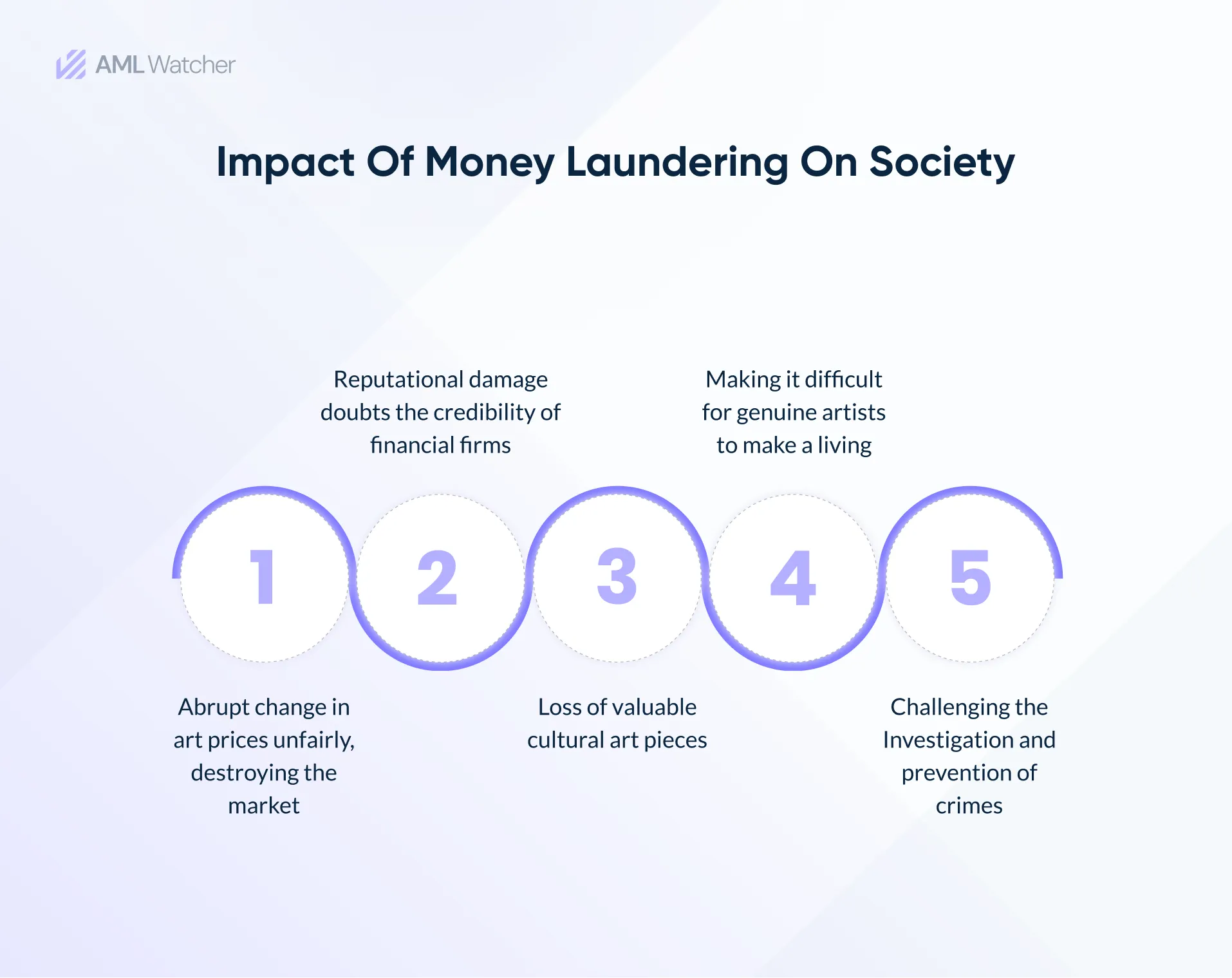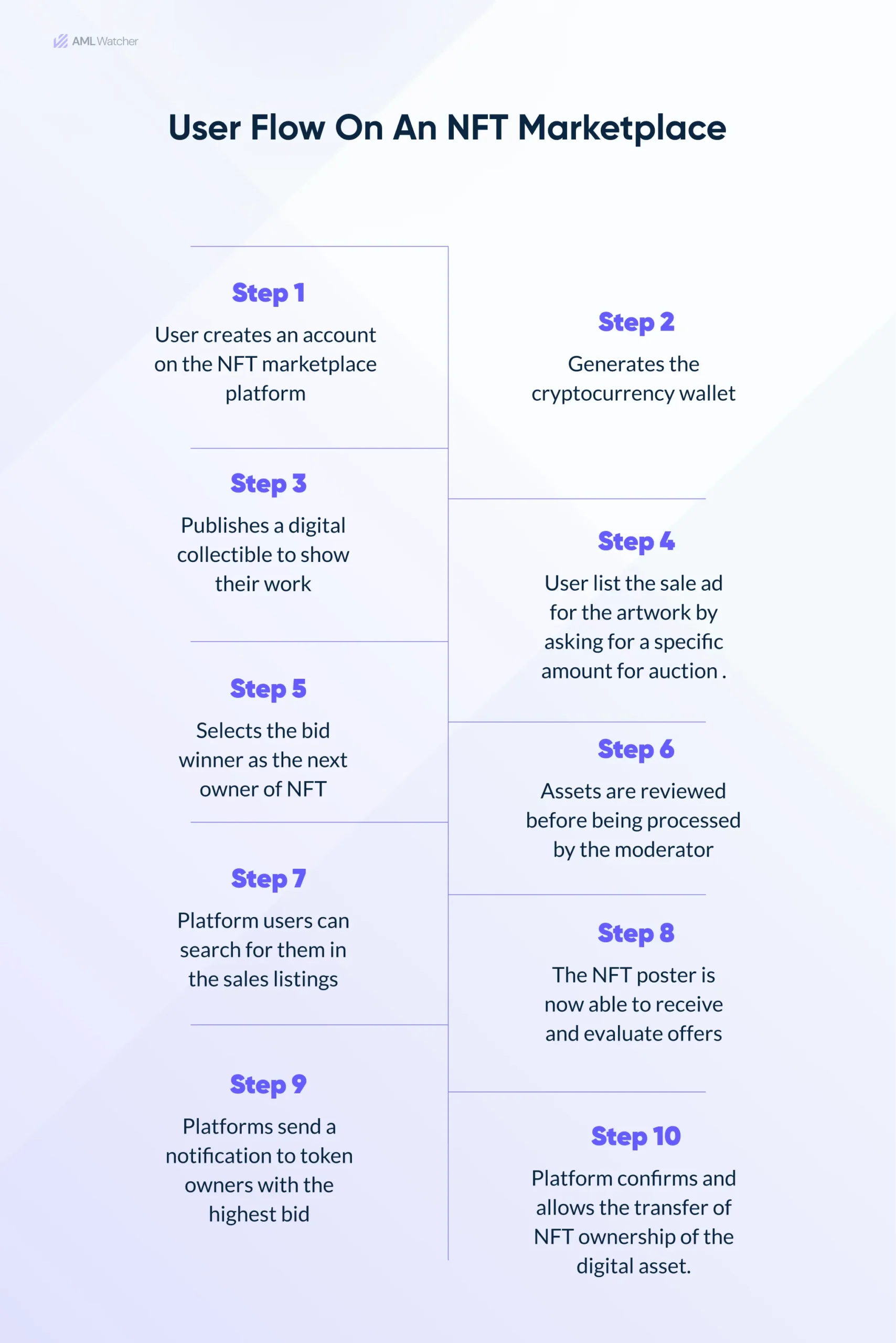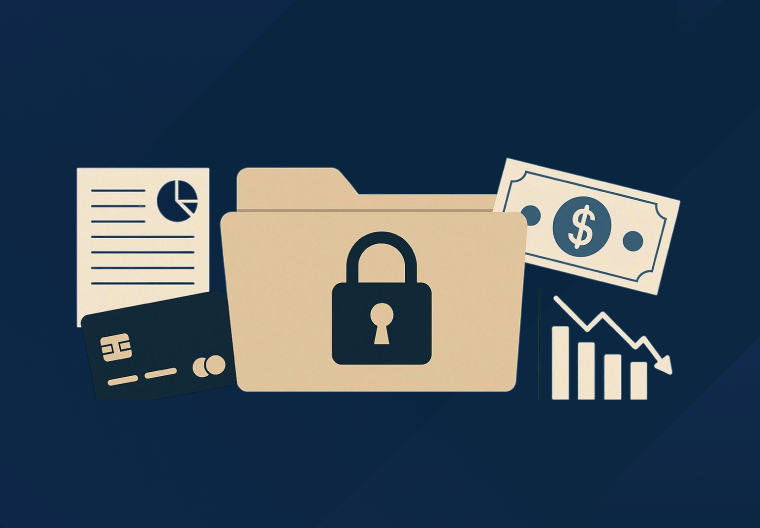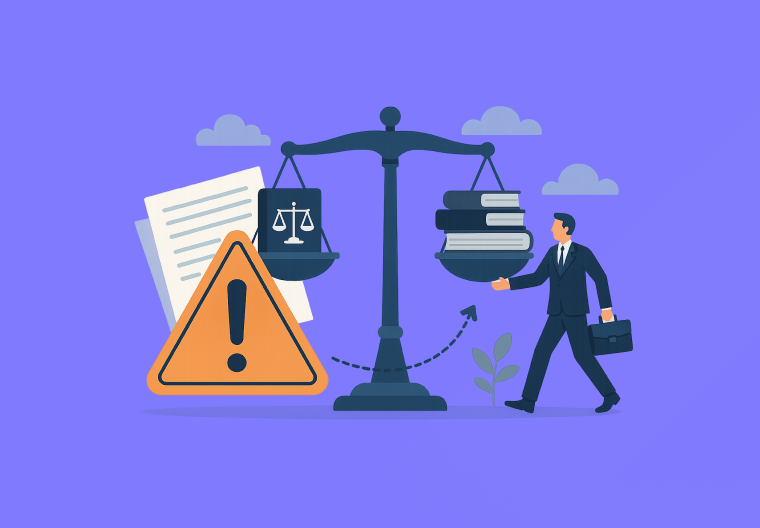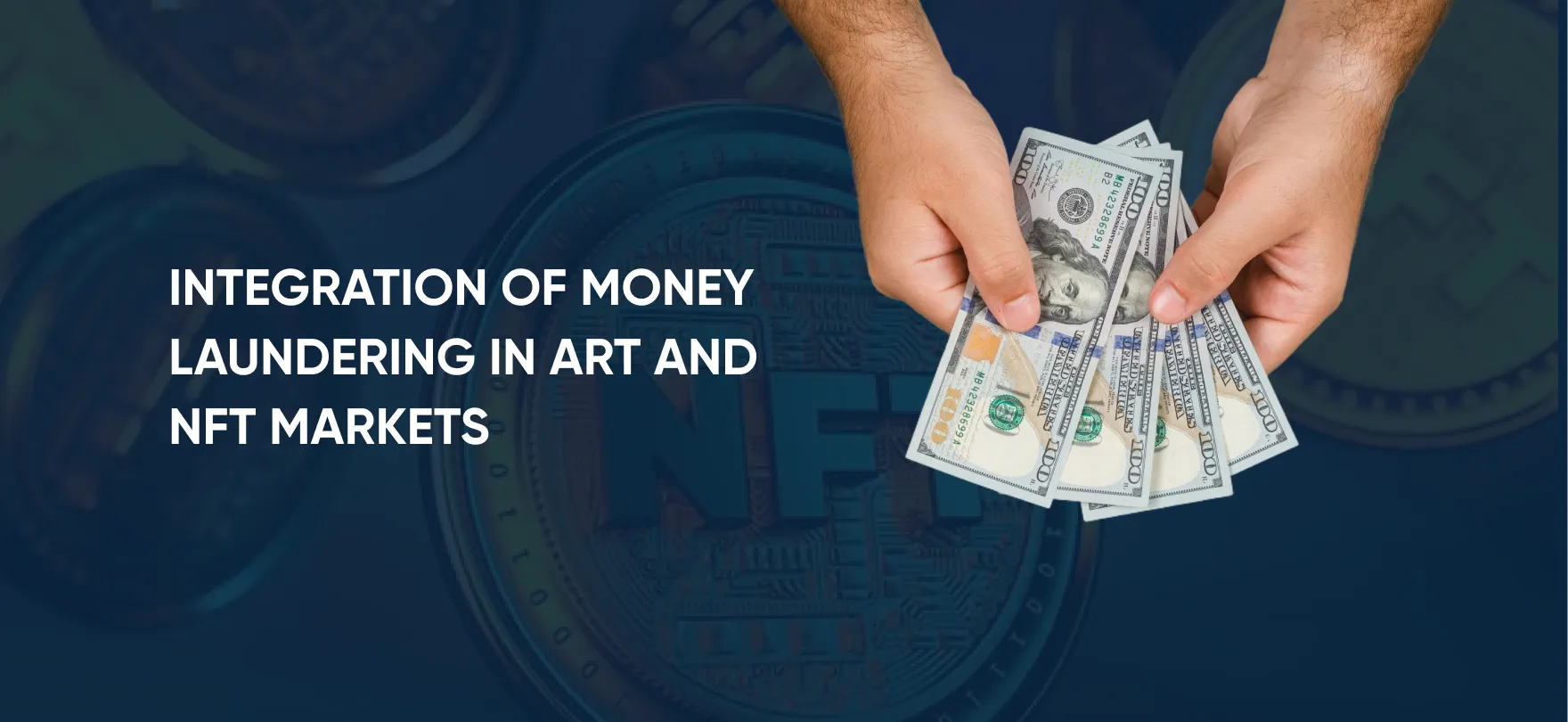
Integration of money laundering in Art and NFT Markets
Have you ever considered how artwork and digital assets provide platforms for money laundering?
The famous case of the Brazilian financier Edemar Cid Ferreira explained how over $30 million was laundered using money art. Authorities arrested him and discovered a hidden treasure of paintings and masterpieces by Picasso and Monet to conceal his dirty money.
Buying and selling artwork to mask the source of funds and integrate dirty money into a clean financial system is a popular method for money laundering. In 2021, wholesalers and auction organizations earned around 65.1 billion USD through artwork and historic item sales.
As technology has evolved, money laundering methods have also improved. Non-fungible tokens (NFTS) are a new playground for money laundering as NFTs are unique digital possessions confirmed by the blockchain approach, having a digital nature and great potential value.
The US Department of Treasury described the word ART as comprising objects like paintings, sculptures, textile artworks, images, historically signified items, high-value cultural items, and digital arts like NFTs.
Money Art As An Attractive Area to Launder Money
Criminals love to avoid penalties and launder money through the safest ways, and for many reasons, the art market is the right choice for their purpose.
Let’s explore the attractive features of the art market for money launderers.
-
Expensive and conveniently transportable goods
Skilled artists charge millions for a single piece of art, and sometimes, it costs more than the place where it is exhibited. Unlike properties, artworks can be quickly sold, transferred worldwide, and displayed secretly.
Have you ever thought a single painting goes on a trip across the borders without being noticed?
Police arrested Ferreira for creating fraud in the Bank to avoid tax and money laundering. Before his arrest, he masked his illegal money by transferring it into artwork. Some pieces from his work were illegally transported from Brazil to New York.
Can you predict that he planned to transport the painting worth $1 million by faking its cost to $100?
An artwork named Hannibal by Jean-Michel Basquiat sold for USD 13.2 million in an auction in 2015, but authorities found out and returned it to its original location in Brazil. However, he tried to escape this artwork by moving to a different place.
-
Absence of laws and a secretive culture
Have you considered that the absence of transparency and laws can encourage money laundering activities in art?
Many regulatory bodies don’t impose AML laws on art transactions, emitting the need to verify the buyer and seller. The EU and UK set important guidelines and laws on art transactions.
Strict rules imply financial institutions in the United States, but art institutions don’t need to follow them. The art market is regulated by’ unwritten rules, ‘ as reported in the 2020 US Senate report.
The US Senate rejected recommendations for applying AML guidelines and laws on art transactions.
Art transactions through vendors and auction houses don’t need to follow AML laws until the money crosses the limit of CHF 100,000 in Switzerland.
A progressive step to change it was taken in March 2022, but Parliament did not discuss it further. Art Sales involve third parties as intermediaries or art consultants who keep buyers’ and sellers’ identities confidential.
They think that if they disclose the names, they will lose future deals, and that’s why secrecy is paramount. Money launderers feel it is the safest method without getting noticed easily.
For instance, Russian oligarchs Arkady and Boris Rotenberg are guilty of bypassing the sanctions by buying artwork worth over $18 million through auction houses and vendors in New York while using shell companies.
-
Opinions-based Adjustable Pricing
The cost of a painting changes dramatically, whereas real estate prices remain somewhat similar. Criminals misuse this opportunity by benefitting from the situation without raising concerns.
For the above explanation, let me give you a reference event!
In 2017, a secretive US federal agent arrested an art trader who used a stock scheme to launder money by conducting a series of planned transactions involving Picasso’s paintings.
The dealer planned to sell the art piece to the agent at a fake cost and then buy the same piece again at a decidedly lower cost. The price difference was the dealer fee, and the final transaction masked the illicit money by showing funds as a legitimate source.
A Hollywood movie, The Thomas Crown Affair, exhibited art manipulation and money laundering. In it, a rich businessman planted a robbery from a museum for personal gains by manipulating the price of art.
-
Availability of freeports
Have you ever imagined a place where you could store high-value, tax-free artwork with little supervision?
Freeports like Geneva Freeport in Switzerland provide secure storage facilities for rich people worldwide to store high-value goods excluded from local tax rules. They store artworks worth millions of dollars without performing customer due diligence checks, and they attract money launderers to evade sanctions and plan money laundering.
Geneva Freeport has been scrutinized for getting caught storing looted artworks and other worthy goods away from regulatory examination.
AML Directives for the Art Market in the UK, EU and USA
The United Kingdom and the European Union have introduced AML regulations for the art market. These guidelines require art market experts to comply with custom due diligence and keep records.
The regulations explain the susceptibility of art trading for money laundering, tax avoidance, and other crimes. The U.S. is far behind in imposing regulations, concentrating only on the antiquities industry.
Art transactions exceeding the €10,000 need to follow AML guidelines according to the EU’s Fifth Anti-Money Laundering Directive (5AMLD) in 2020, and the UK decided to modify the directive according to its requirement to combat money laundering.
France experienced a 35% increase in unusual activities reported by the auction business and a 47% rise from fine art and jewelry traders in the art market from 2016 to 2020.
Due to excessive regulation and its complexity, the art market faces many challenges and criticisms. Experts give opinions about the insufficiency of AML programs in auction houses.
The U.S. Treasury’s report in 2022 did not approve the suggested guidelines, although it knew all the concerns. The report accepted that the art market is vulnerable to money laundering but suggested focusing on other fields for AML regulation.
The Anti-Money Laundering Act, 2020 has set new guidelines for antiquities traders in the US to fight against money laundering. Before this act, only banks and other financial organizations used to follow these rules, but now antiquities dealers must:
- Have solutions to combat money laundering and terrorist financing.
- Check the beneficial owners of items.
- Have Training programs for staff on Anti-money laundering.
- Keep data on transactions.
- Report unusual activities to regulatory authorities.
- Daily examine their compliance and record keeping.
However, art dealers are still not controlled under these guidelines.
Following AML guidelines would prevent future crime planning like those that happened in the past.
How does modern art money laundering work?
Let’s uncover the planned schemes behind money laundering art.
-
Purchase
A criminal buys a worthy art piece involving shell companies or a third party in a renowned auction or exhibition hall.
-
Freeport storage
Criminals feel safe and secure using freeports. By preserving the artwork in a freeport, they avoid customs charges and taxes.
-
Layering through transactions
Criminals sell art pieces multiple times to avoid authorities’ attention without leaving the freeport. This layering process raises the cost of art pieces and masks the original source of funds.
-
Perks of being an owner
Although Criminals own the artwork, they introduce illicit money into the financial system using artwork as collateral for loans.
-
Ultimate sale and integration
Selling the artwork at an increased price to a genuine buyer washes away dirty money and produces clean, legitimate funds.
-
Checking out the freeport
When art pieces finally leave the free port, they face custom guidelines and tax, but the complicated transaction history of illicit funds makes it harder to track down their source.
Shift to NFT Money Laundering
NFTs known as (non-tangible tokens) are the digital assets stored on the blockchain, which are entirely different from cryptocurrency. They are distinct digital assets stored on the blockchain.
NFTs permit digital and physical goods, such as ownership of artwork, videos, music albums, and virtual real estate. Cryptocurrency can be exchanged one for one, but NFTS can’t be swapped for another NFT.
NFT is the product you are purchasing, and crypto is the way through which purchasing happens. OpenSea, Raribe, or Nifty Gateway are NFTs marketplaces. Marketplaces permit you to store NFTs in your wallets for storage.
In 2021, the Digital artist Beeple sold the popular NFT “Every day: The First 5000 Days’’ for $69 million.
Famous NFTs like Bored Ape Yacht Club, Cryptokitties, and VeeFriends are Advertised as collectibles.
Artists use NFTs to sell their work directly to customers, avoiding traditional intermediaries and maintaining the uniqueness of their products.
NFTs Trade Market as Opportunities Hub
The NFT market provides criminals with the safest trading platform. Users’ identities remain unknown, making it difficult to trace them. Anyone who takes part in this market has open access without going through a strict verification process, making it easy for criminals to intrude into the system.
The cost of NFTs can be altered easily, allowing criminals to launder money by increasing the process and masking the illicit funds by showing them as legitimate money.
The exchange of Bitcoin to EUR follows market supply and demand regulations, while NFT prices are highly volatile. An NFT purchased for €1 can be sold for €1 million the next day.
Ways to utilize NFTs in Money laundering
Have you ever thought your favorite digital art could be used for Monday laundering? You will doubt it after reading about the schemes used in NFT money laundering, which are described below.
-
Wash Trading
Wash trading technique, which involves continuous purchasing and selling of NFTs with different accounts helps in increasing NFTs’ costs through a series of transactions helps to make illicit funds appear like legitimate funds.
Imagine Jack using his clean money and buying an NFT for $10. Later, he repurchased the same NFT for $1,000 using his different account, which was supported by illegal money.
He continues the cycle multiple times, building a record of highly valuable transactions. Lastly, Jack sells the NFT for $1,200 to an unsuspecting purchaser, successfully introducing illicit money into a legitimate economy.
-
Fast transactions
In the blink of an eye, NFTs can be quickly sold worldwide without any barrier through rapid transactions. Criminals use multiple platforms or user accounts to complex the transcription process for transaction identification and verification.
Tracking the primary source of the funds seems impossible, and integrating illegal money into a clean system becomes easy.
-
Benefiting from shell companies
Criminals can buy NFTs worth massive amounts through shell company, preserve them in freeports for tax evasion, and then sell them multiple times to achieve the main goal, masking the money’s source.
Regulations for NFT money laundering
Guidelines for NFTs and crypto assets need development.
NFT money laundering across borders requires international guidelines to combat the situation. Some nations manage it with few guidelines, and some follow strict measures. Proper coordination between nations should emit weaker guidelines.
Prevention of NFT money laundering
NFT money laundering disturbs the transparency and security of the financial environment. Innovative technology and processes help detect and prevent NFT money laundering, increasing the stability of the market.
Let’s discover regulatory guidelines and framework for this purpose:
-
Know Your Customer (KYC)
NFT marketplaces should know how to apply KYC techniques to confirm user identities and check transactions for unusual activities. This includes enhanced due diligence for high-risk profiles and transaction screening.
-
Regulatory Oversight
If you follow the rules and regulations and comply with the latest prevention measures, you could skip the headache you will face tomorrow because you made up preventive measures for it. The Financial Action Task Force (FATF) suggested due diligence for high-value NFT transactions.
Due diligence acts like a shield against money laundering in the NFT marketplace. The Anti-Money Laundering Act of 2020 in the United States imposed AML standards on certain industries. This act involves due diligence and notifying authorities of unusual activities.
-
Accessibility of Public Blockchains
Detecting suspicious activities is easy by using transaction history through public blockchains. Blockchain transparency facilitates monitoring the source and digital flow of assets, which helps detect suspicious transactions.
Opportunities to launder money in safe places, evade taxes, and escape transaction monitoring make it easier for criminals to launder money. Crack the code to stop the spread of money laundering.
AML Watcher To Combat Art And NFT Money Laundering
AML Watcher played a significant role in NFT and Art Anti Money laundering by continuously monitoring transactions to identify unusual activities and ensuring effective KYC processes prevent unknown transactions.
It performs enhanced due diligence for high-risk customers and businesses, conducts risk assessments, and creates compliance data. Evolved algorithms detect suspicious behavior to detect abnormalities, and the program helps establish relationships with regulators by giving detailed investigative reports.
Furthermore, AML Watcher provides resources and awareness to help businesses increase transparency, safeguard their reputation, prevent crime, and comply with AML regulations.
Contact us to benefit from AML Watcher’s services, increase productivity, and enhance compliance. Our team will assist you according to your requirements and specifications.
We are here to consult you
Switch to AML Watcher today and reduce your current AML cost by 50% - no questions asked.
- Find right product and pricing for your business
- Get your current solution provider audit & minimise your changeover risk
- Gain expert insights with quick response time to your queries
